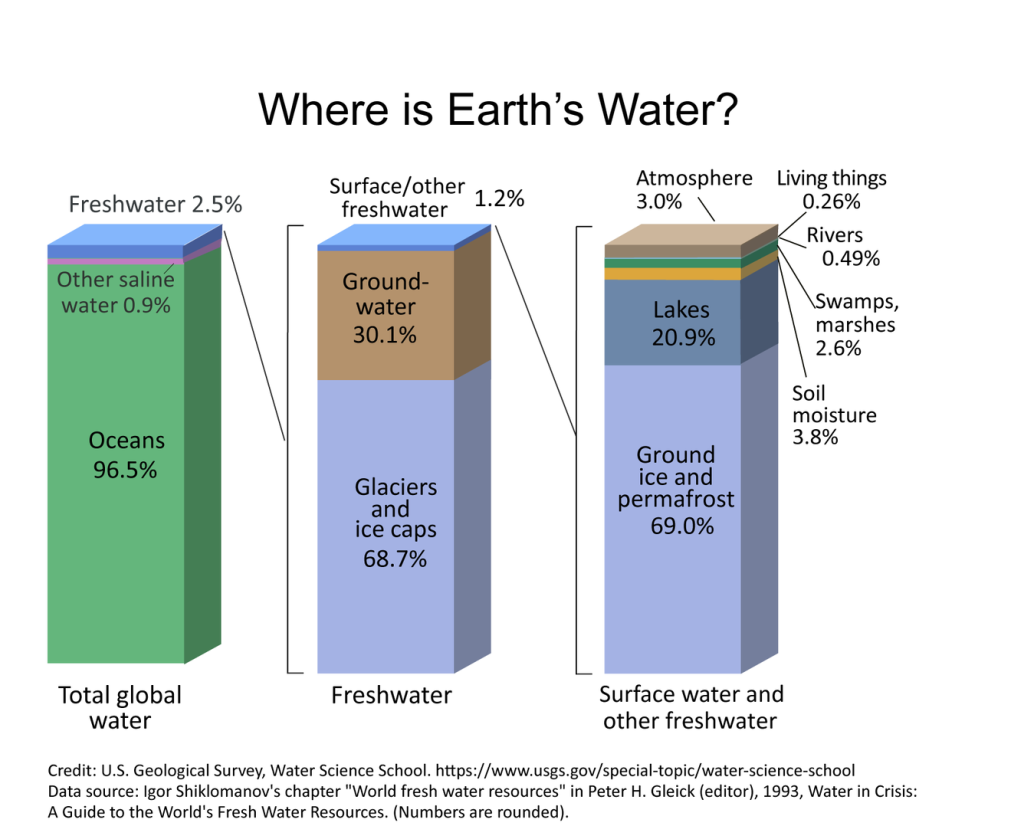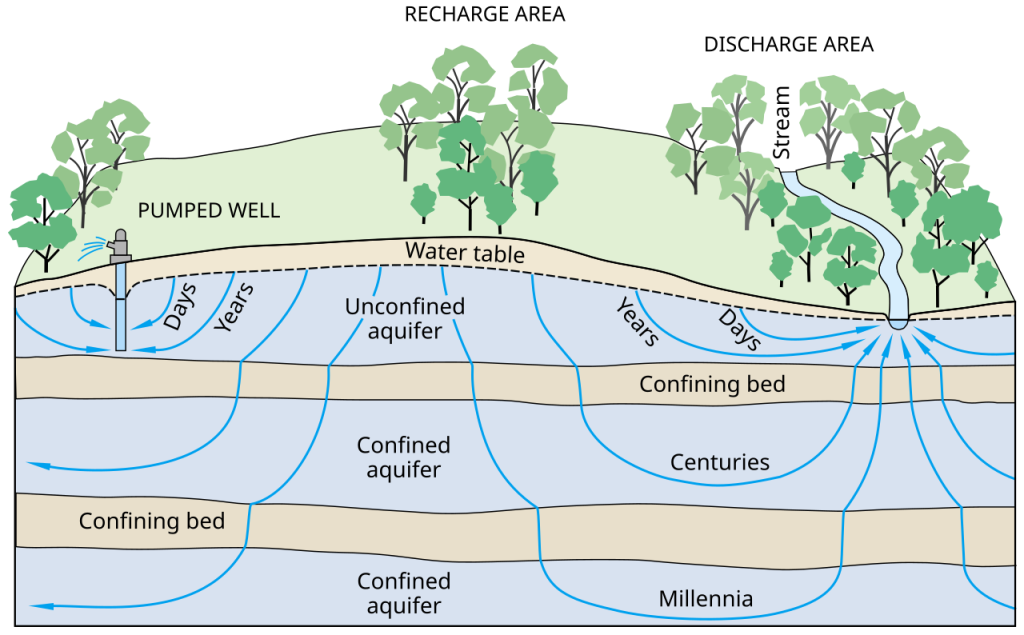3.1 The Water Resource
Amounts and kinds of water
Of the various kinds of water, humans rely most heavily on surface freshwater. Yet, this comprises only a tiny fraction of all the water on this water planet (Fig 1).

Figure 1. Global water availability.
Liquid freshwater in groundwater is about 30% of 2.5% or 0.7% of total global water. Liquid, surface freshwater in rivers, lakes, and wetlands is about 24% of 1.2% of 2.5% or 0.007%. Further, a 2021 United Nations report estimated that about 40% of monitored freshwater bodies did not meet the standard for good ambient water quality due to water pollution.
Figure 1 divides water resources between saltwater and freshwater, and then divides freshwater between a variety of liquid and frozen forms. Liquid freshwater resources can be divided between surface water and groundwater (Fig 2). Surface water occurs above the ground, in lakes, rivers, and wetlands. Groundwater, as the name suggests, is water in the ground. But it may be water immediately under the land’s surface or it may be water under rock layers far below the Earth’s surface.

Figure 2. Groundwater, aquifers, and groundwater withdrawal. T.C. Winter, J.W. Harvey, O.L. Franke, and W.M. Alley, Public domain, via Wikimedia Commons
An unconfined aquifer is a water layer just below the land’s surface, in the soil. The top of the unconfined aquifer is called the water table. Where the land dips below the top of the confined aquifer, surface water occurs in the forms of lakes, rivers, and wetlands. Surface water, rainfall or melting snowfall can add water to the unconfined aquifer (called recharge) quickly because the water merely needs to percolate through the soil to reach the unconfined aquifer. If water is plentiful, the unconfined aquifer can contribute water to surface-water bodies, as in the figure above, where blue lines point to the stream; if water is less plentiful, then the water table will be lower and flow direction will likely be from surface water to the unconfined aquifer.
Confined aquifers are separated from the land’s surface by one or more confining layers that significantly slow percolation of water (an aquitard – for example, a clay layer) or prevents it entirely (an aquiclude – for example, and rock layer). Confined aquifers can occur in several layers, separated by confining layers. Just as the unconfined aquifer isn’t pure water but is soil or sand or gravel saturated with water, confined aquifers are layers of porous rock or sand or gravel saturated with water. Precipitation recharges confined aquifers over longer periods, ranging from years to millennia.
A well that taps into an unconfined aquifer and removes water creates a local depression in the water table. The area and depth of the depression is a balance between the amount of water withdrawn and the amount of recharge from local precipitation. Withdrawal may thus be sustainable or unsustainable. If the depression is extensive or prolonged, the ground in the area may become compressed without water to support it, and the land may subside, creating a surface depression or a sinkhole.
A well that taps into a confined aquifer is tapping an essentially nonrenewable resource – human use occurs faster than recharge, so the confined aquifer is constantly depleted. As the confined aquifer is drained, the overlying confining layers lose the support of the water and may crack or subside, leading to subsidence at the surface, as well. In addition, collapse of deeper layers may lead to drainage of any unconfined aquifer as well as surface water in rivers or lakes into the deeper layers.
Natural Processes that Contaminate and Purify Water – move this somewhere else, eventually
Natural processes both contaminate and purify water. Organic material from dead plants and animals enters water bodies constantly, contributing a variety of substances to the water. As rain runs over rocks and soil, it leaches out soluble minerals – this is the process that creates salty oceans. Early in Earth’s history, water bodies would have held relatively little salt, although they might have been very acid, due to volcanic gases that create acid rain (and acid snow and acid fog). Natural oil seeps, arsenic deposits, radioactive deposits, disease organisms, and flood-borne materials all decrease water quality, naturally.
Waters that overlie limestone, or that receive runoff and percolation from productive soils receive nutrients that can support healthy plankton blooms. Waters with high nutrient levels, whether caused by human mismanagement of nutrients or by naturally high nutrient levels are called eutrophic. Low-nutrient waters are termed oligotrophic and are often associated with areas with less soil and rock types, such as granite, that provide little or no nutrient value when they decompose.
In eutrophic waters, algae can become numerous and reduce water clarity. They are short-lived – usually only a few days – and when they die, they sink to the bottom, where bacteria decompose them, using oxygen. But oxygen only diffuses from the atmosphere to the bottom of lakes slowly. As a result, oxygen levels near the bottom of the lake can become quite low, making the bottom waters inhospitable for fish, mollusks, invertebrates, and other aquatic life. In contrast, water in oligotrophic lakes tends to be well oxygenated, but it does not support abundant plant life (which is the bottom of food webs) and so these lakes tend to have sparse populations of aquatic life.
Dilution is a natural means of improving water quality, particularly for flowing waters or large bodies of water. A small stream that carrying lots of sediment after a flood may join a larger stream, diluting the sediment levels and improving water clarity.
Ecosystem processes that improve water quality include filtration and sediment trapping, nutrient removal, and detoxification. Plant roots can trap soil, preventing erosion and keeping sediment (and associated contaminants) out of the water. As water percolates through soil, some contaminants are adsorbed onto soil particles, some may be taken up by plant roots or by bacteria on the soil or on plant surfaces. Plants and bacterial may be able to break down and detoxify contaminants or may simply isolate them within their bodies, at least for a time. Nutrients can be taken up by plants and used to produce more biomass. Under some circumstances, wetlands can be used for some phases municipal water treatment, with the nutrients from sewage supporting wetland plant growth (which may, in turn, require harvest of the plant biomass, if it becomes overcrowded).
Media Attributions
- EarthsWater-BarChart.USGS © USGS is licensed under a Public Domain license
- Groundwater_flow.svg © T.C. Winter, J.W. Harvey, O.L. Franke, and W.M. Alley is licensed under a Public Domain license
Diffusion is a process in which substances in liquids or gases naturally move from areas of high concentration (oxygen in the atmosphere, here) to areas of low concentration (oxygen in the bottom waters). A more familiar example is sugar at the bottom of a cup, which slowly diffuses throughout the water in the cup.
Adsorption occurs when substances are bound to a surface, either physically or chemically. Because some soil particles carry electrical charges, some chemicals can be electrically attracted to soil, and can become bound to it.
